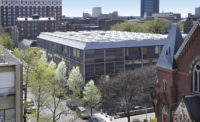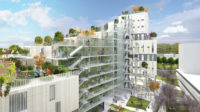Chicago, IL

|
|
Photo: © Christopher Barrett
|
Across the country, corporations whose fortunes are built on indefatigable twentysomethings are reverse-migrating from suburbia to cities, where many young professionals prefer to live. At the leading edge of this trend, energy giant BP moved its trading and treasury departments in 2010 from a corporate campus in Warrenville, Illinois, to downtown Chicago, where it now occupies three floors of the Chicago Mercantile Exchange (CME) building. To make the move work, the company teamed with Gensler to replace existing interiors that had been cobbled together from conference rooms. “You could never achieve functionality by keeping traders apart from their support networks,” Dane Rausch, Gensler senior associate and design director in the firm’s Chicago office, says of those old spaces scattered over multiple floors.
The Gensler team placed the traders on a 24,000-square-foot trading floor that can seat 500 people. To do this, the architects fashioned a pit from the original CME that soars three stories high, and built acoustically separated mezzanines around it to house the main cafeteria, as well as BP’s treasury department. Teaming, conference, and training zones and a smaller caf' also line the perimeter.
To facilitate the retrofit, the building owner punched two 160-foot-wide apertures into the east- and west-facing elevations bookending the trading floor, and double-glazed the new openings in a manner sympathetic to the fenestration of the entire building. “Early on everybody thought that, by knocking floor-to-ceiling holes in the wall, we wouldn’t need to light this huge trading floor,” recalls lighting designer Mark Sills, of CharterSills. Yet shadow studies revealed that the length of the floor prevented full daylight penetration. To illuminate the space evenly and thoroughly, CharterSills suspended two-lamp T5 luminaires from the trading floor ceiling, which spans a whole city block. This reduced glare, and—compared with an early concept that treated lighting as furniture—minimized visual obstacles for employees in the mezzanines.
A sophisticated control system operates shades installed along the new curtain walls, responding to the sun’s position and intensity. The same digital cues impact the T5s, which brighten and dim in four zones grouped by their distance from the giant windows. To access the trading floor, employees and visitors pass through one of eight corridors. T5s embedded in drywall create flush, vertical bands of white light that are a playful counterpoint to the flood of light on the trading floor.
CharterSills standardized lamp types throughout the project, using mostly linear T5s. “A design with thousands of different things may look perfect on day one, but you can’t maintain it,” Sills says. In addition to providing a uniform 3500 Kelvin color temperature, this strategy made the most of existing ceiling heights; in more intimate interior volumes like elevator lobbies or breakout areas, the designers installed CFL downlights to avoid expanding the plenum and to create a wall wash that makes those spaces seem larger. Similarly, controls of varying complexity are installed to correspond with the function'of a space. For example, closets include occupancy sensors, a teaming room may have a simple switch, and conferencing facilities operate on presets. Although BP wanted wow-factor lighting design, Sills says the project demanded realism for the sake of its own long-term viability: “Just because something has bells and whistles doesn’t mean we have to employ them.”
People
Architect:
Lighting Design:
Client:
Engineers:
General Contractor:
Size:
Cost:
Completion Date: |
Products
Lighting:
Curtain Wall: |




Post a comment to this article
Report Abusive Comment